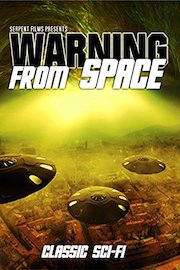-
Genres
-
MPAA RatingNR
-
Runtime1 hr 27 min

Warning From Space is a classic sci-fi movie from Japan that was first released in 1956. Directed by Koji Shima, the film offers a unique perspective on the extra-terrestrial world, which was not present in the popular 1950s Hollywood sci-fi films. The movie is set in Japan, where a falling star surprises astronomers because its trajectory is unusual. The scientists take a closer look and realize that the object is not a meteor at all, but an extraterrestrial spacecraft. The aliens inside are trying to warn the people of earth about impending disaster. However, the humans are not quick to welcome the ETs with open arms, and the aliens are forced to take a more proactive approach to get their message across.
The movie touches on several themes, including the dangers of nuclear warfare, responsibility for the safety of planet earth, and the fear of the unknown. The interstellar visitors are not depicted as violent or dangerous, but rather as peaceful beings with a message to deliver. The film's portrayal of non-human life forms was ahead of its time, portraying the aliens as friendly, rather than hostile, which was a common trope in sci-fi films.
One of the most noticeable aspects of the film is the use of miniature models and special effects; the attention to detail is impressive, especially when considering the era in which the movie was produced. The special effects team, led by Teruaki Abe, used puppets and models to create the aliens and their spaceship, as well as the destruction of Earth's landmarks.
Aside from the spectacular visual effects, the movie also features a unique soundtrack. Composer Toshiro Mayuzumi utilizes the Ondes Martenot, an electronic musical instrument that approximates the sound of the human voice, to create a haunting and evocative score. This creates an eerie and otherworldly atmosphere for the film and complements the visuals.
The film's pacing is somewhat slow by modern standards, but this allows for character development and a deeper exploration of the themes at play in the story. The characters are well-defined and human, so audiences can easily become invested in their journeys.
The movie's themes of nuclear weapons were no coincidence; in the 1950s, Japan was rebuilding from the devastation of World War II and was acutely aware of the damaging effects of nuclear weapons. The film posits that man's war-like tendencies could be the end of us all, but also provides a glimmer of hope that alien intervention could save the human race.
Despite the less-than-human appearance, the aliens in Warning From Space display several characteristics associated with humanity, including kindness and compassion. They are portrayed as beings from a higher plane of existence, worried about the humans' fate and their capacity for self-destruction. This is a vastly different approach to the cliché of extraterrestrial enemies looming over humanity to attack and destroy.
The film is a product of its time and contains some elements that might seem outdated by modern standards. For example, women are portrayed as secondary to men in the plot. However, the movie's inclusiveness is noteworthy, as the cast and characters present a diverse array of appearances and backgrounds.
The film's impact on popular culture is undeniable. The iconic imagery associated with the aliens has been referenced and parodied in several movies, TV shows, and video games. Additionally, the visuals and special effects techniques utilized in the movie helped pave the way for future sci-fi movies.
In conclusion, Warning From Space is not just a sci-fi classic, but a poignant and thoughtful critique of humanity's place in the universe. With its innovative use of special effects, a haunting soundtrack, and thoughtful storytelling, this movie deserves its status as a landmark sci-fi film. Although some aspects of the plot seem dated today, the film remains an enjoyable, thought-provoking watch that is sure to delight fans of the genre.